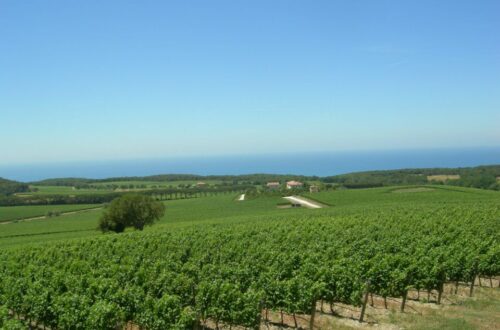Table of Contents
What Is Atina DOC?
Tucked away in Lazio’s Comino Valley, Atina DOC is one of Italy’s youngest appellations, officially recognized in 1999. Here, French varieties—Cabernet Sauvignon, Cabernet Franc, Merlot, Syrah, and Sémillon—found a second home on Apennine slopes, producing distinctive wines far from Italy’s mainstream regions. With fewer than 15 producers and an output of roughly 5,000 cases annually, Atina DOC remains one of Italy’s best-kept wine secrets.
History: From Visocchi’s Vision to Modern DOC
Atina’s viticultural story begins in the 19th century with Pasquale Visocchi, a forward-thinking agronomist who first planted Cabernet and Sémillon in this remote valley. His experiments predated Italy’s modern DOC system by a century.
After decades of decline and abandonment, local producers revived Visocchi’s legacy in the late 20th century, leading to Atina’s DOC designation in 1999. Today, the region represents both a tribute to tradition and a showcase of resilience, blending French varietals with Italian terroir.
Geography and Terroir of the Comino Valley
Nestled between the Abruzzo National Park and Campania’s rugged borders, the Comino Valley offers a dramatic viticultural setting.
- Altitude: Vineyards sit between 250–500m, creating cool nights that preserve acidity.
- Soils: Rich in clay and limestone, ideal for structured reds.
- Climate: Mountain influences ensure fresh breezes and long ripening seasons.
This unique terroir allows Cabernet Sauvignon and Sémillon to achieve an Italian accent—bold yet balanced, with elegance uncommon in central Italy.
Grape Varieties: Cabernet Sauvignon and Sémillon
While Cabernet Sauvignon dominates, Atina’s DOC rules allow blends with Merlot, Syrah, and Cabernet Franc. The whites, led by Sémillon—rare in Italy—offer a distinctive point of difference, making Atina one of the country’s most unusual DOCs.
- Reds: Cabernet-driven blends with dark fruit, spice, and mountain freshness.
- Whites: Sémillon, sometimes blended with Malvasia or Trebbiano, bringing waxy texture and citrus lift.
Wine Styles and Production Rules
Atina DOC wines come in several categories:
- Atina Rosso DOC – Cabernet Sauvignon (min. 50%) plus Merlot, Syrah, or Cabernet Franc.
- Atina Cabernet DOC – At least 85% Cabernet Sauvignon, with aging potential.
- Atina Bianco DOC – Sémillon (min. 50%), offering rare white expressions from central Italy.
Tasting Notes and Food Pairings
- Atina Rosso: Notes of blackberry, cassis, leather, and spice. Pairs beautifully with lamb, wild boar ragù, or aged Pecorino di Picinisco DOP.
- Atina Cabernet: Richer, cellar-worthy reds with firm tannins—perfect with steak alla griglia or venison.
- Atina Bianco: Fresh, floral whites with hints of citrus and almond, ideal alongside fried zucchini blossoms or seafood risotto.
Wine Tourism in Atina and the Comino Valley
Atina’s true charm lies in combining wine tasting with cultural exploration:
- Vineyard Visits: Family-run estates welcome travelers for intimate tastings.
- Borghi più belli d’Italia: The medieval town of Atina is officially one of Italy’s “Most Beautiful Villages.”
- Harvest Festivals: September–October brings grape harvest celebrations.
- Day Trips from Rome: Just two hours from the capital, Atina offers an off-the-beaten-path alternative for wine travelers.
- Comino Valley Experience: Pair winery tours with hikes, truffle hunting, or visits to the Abbey of Montecassino.
Tip: Many travelers combine Atina’s vineyards with Rome, Naples, or Abruzzo National Park for a well-rounded cultural journey.
Comparison: Atina vs Other Lazio Wines
- Atina vs Frascati: Frascati is Rome’s white-wine darling, while Atina is Cabernet-focused and red-dominant.
- Atina vs Cesanese del Piglio: Cesanese offers indigenous Lazio flavors; Atina highlights international varietals in a mountain terroir.
- Atina vs Montepulciano d’Abruzzo: Both regions share mountain influences, but Atina wines remain smaller-scale and collector-oriented.
Where to Buy Atina DOC Wines
Atina wines are produced in limited quantities, making them highly collectible. Look for bottles through:
- Local estates in Lazio’s Comino Valley.
- Specialist Italian wine importers in the US, UK, and Northern Europe.
- Online shops specializing in “hidden gem” Italian wines.
CTA for Audience Engagement
🍷✨ Have you discovered Atina DOC yet? Share your tasting experiences or travel stories with us on Instagram @DrinkItalian. For insider guides to Italy’s rarest appellations, subscribe to our newsletter and be the first to explore Italy’s hidden wine gems.


